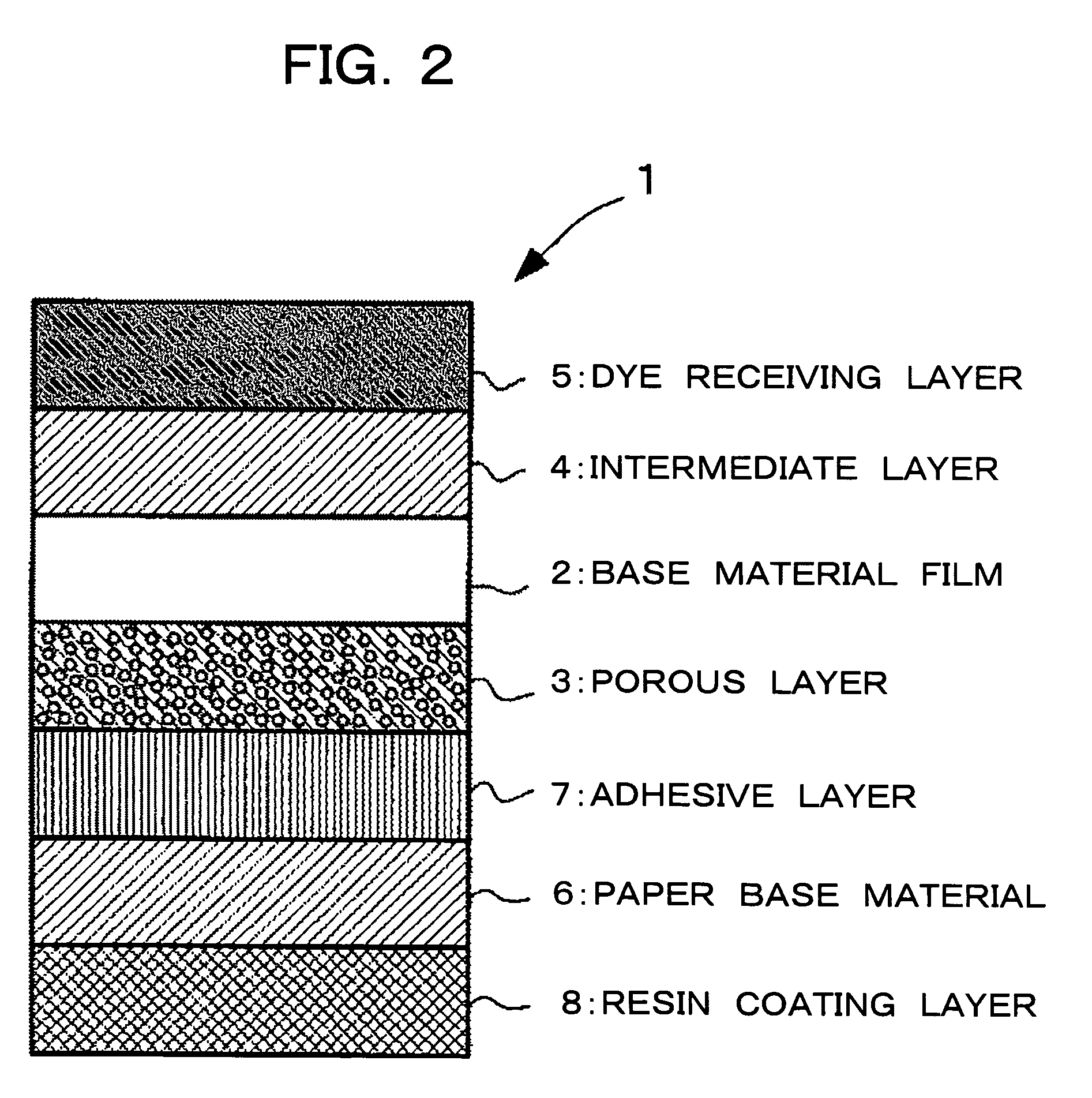Thermal transfer image receiving sheet and method for manufacturing the same
a technology of thermal transfer and receiving sheet, which is applied in the direction of thermography, duplicating/marking methods, printing, etc., can solve the problem of drastic increase in cost, and achieve the effect of high cushion property, high thermal transfer performance, and cheap and efficient manufacturing
- Summary
- Abstract
- Description
- Claims
- Application Information
AI Technical Summary
Benefits of technology
Problems solved by technology
Method used
Image
Examples
first embodiment
FIG. 1B shows the cross sectional structure of a thermal transfer image receiving sheet 1 according to an embodiment of the present invention, and FIG. 1A shows the state of the halfway of the formation of the thermal transfer image receiving sheet 1. In FIGS. 1A and 1B, the layers are described in a constant thickness for the convenience regardless of the actual thicknesses in the thermal transfer image receiving sheet. As shown in FIG. 1A, the thermal transfer image receiving sheet 1 is manufactured by forming a porous layer 3 on the lower surface side of a base material film 2 and an intermediate layer 4 and a dye receiving layer 5 on the upper surface side successively so as to provide a laminated member 1A, and attaching a paper base material 6 on the lower surface of the porous layer 3 of the laminated member 1A via an adhesive layer 7.
It is preferable that the base material film 2 does not absorb the moisture content or barely absorb the same at the time of coating the poro...
second embodiment
Hereinafter, the second embodiment of the present invention will be explained. FIG. 3 is a schematic cross sectional view showing an example of a thermal transfer image receiving sheet of a second embodiment of the present invention.
It is a thermal transfer image receiving sheet 10 having an adhesive layer 30, an insulation layer 40, a thin film 50 and a receiving layer 60 laminated successively on a base material sheet 20. The insulation layer 40 is formed by providing a resin layer containing a foaming agent or a thermally expansible micro capsule to the thin film 50, and foaming or expanding the resin layer by contacting the resin layer with an extruded resin at the time of EC laminating the resin layer side of the thin film 50 and the base material sheet 20. The layer formed by the extruded resin to be EC laminated is the adhesive layer 3.
The thermal transfer image receiving sheet of the present invention is not limited to the embodiment shown in FIG. 3, and a layer can be ...
example 1-1
By coating an intermediate layer and a dye receiving layer of the below-mentioned compositions on one side surface of a polyester film (produced by Toray Industries, Inc., product name: LUMIRROR) having a thickness of 6 μm as the base material film each in a dry coating amount of 2.0 g / m2 and 4.0 g / m2 by the gravure coating method, and drying them, the intermediate layer and the dye receiving layer of the ther0mal transfer image receiving sheet of Example 1-1 was formed.
(1) Intermediate layerPolyester resin (VYLON 200, produced 10 parts by weightby Toyobo Co., Ltd.)Titanium oxide (TCA-888, produced by 20 parts by weightTohkem Products Co., Ltd.)Methyl ethyl ketone / toluene = 1 / 1120 parts by weight
(2) Dye receiving layerVinyl chloride.vinyl acetate copolymer100 parts by(Denki Kagaku KogyoKabushiki Kaisha, #1000 A)weightAmino modified silicone 5 parts by weight(Shin-Etsu Chemical Co., Ltd.,X22-3050C)Epoxy modified silicone 5 parts by weight(Shin-Etsu Chemical Co., Ltd.,X22-3000E)Met...
PUM
| Property | Measurement | Unit |
|---|---|---|
| thickness | aaaaa | aaaaa |
| thickness | aaaaa | aaaaa |
| thickness | aaaaa | aaaaa |
Abstract
Description
Claims
Application Information
 Login to View More
Login to View More - R&D
- Intellectual Property
- Life Sciences
- Materials
- Tech Scout
- Unparalleled Data Quality
- Higher Quality Content
- 60% Fewer Hallucinations
Browse by: Latest US Patents, China's latest patents, Technical Efficacy Thesaurus, Application Domain, Technology Topic, Popular Technical Reports.
© 2025 PatSnap. All rights reserved.Legal|Privacy policy|Modern Slavery Act Transparency Statement|Sitemap|About US| Contact US: help@patsnap.com



